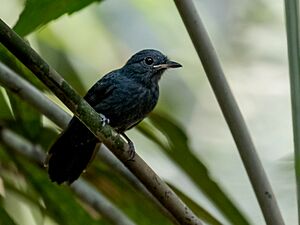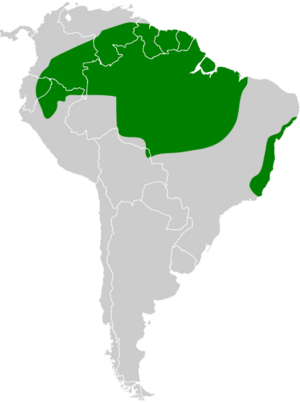Cinereous antshrike facts for kids
Quick facts for kids Cinereous antshrike |
|
|---|---|
 |
|
 |
|
| Conservation status | |
| Scientific classification | |
| Genus: |
Thamnomanes
|
| Species: |
caesius
|
 |
|
The cinereous antshrike (Thamnomanes caesius) is a bird that eats insects. It belongs to a group of birds called "typical antbirds." You can find this bird in many South American countries, including Bolivia, Brazil, Colombia, Ecuador, French Guiana, Guyana, Peru, Suriname, and Venezuela.
Contents
About the Cinereous Antshrike
What's in a Name?
The cinereous antshrike was first described by a Dutch zoologist named Coenraad Jacob Temminck in 1820. Its scientific name is Thamnomanes caesius. The word caesius comes from Latin and means "bluish gray," which describes the bird's color.
This bird belongs to a group, or genus, called Thamnomanes. This group was named by a German scientist, Jean Cabanis, in 1847.
For a while, some scientists thought the cinereous antshrike and the bluish-slate antshrike were the same species. Now, they are seen as very close relatives.
There are five different kinds, or subspecies, of the cinereous antshrike:
- T. c. glaucus
- T. c. persimilis
- T. c. simillimus
- T. c. hoffmannsi
- T. c. caesius
What Does It Look Like?
The cinereous antshrike is a small bird. It is about 14 to 15 centimeters (5.5 to 6 inches) long. It weighs around 16 to 18 grams (0.56 to 0.63 ounces), which is about as much as a few quarters.
Male cinereous antshrikes are mostly dark gray. They have white on the inner edges of their wing feathers. Female birds are olive-brown on their upper parts. They have a small white patch on their back, between their shoulders. Their wings and tail are also olive-brown, sometimes with a reddish-brown tint. Their throat is a light tan color, and their belly can be olive or reddish-brown.
The different subspecies have slight differences in their colors. For example, some males might be a lighter gray or have white streaks on their face. Females can have different shades of reddish-brown on their bellies.
Where Does It Live?
The cinereous antshrike lives in different parts of South America. Its home range is not all connected.
You can find these birds in the understory (the plants below the main tree canopy) and mid-story of evergreen forests. They prefer forests that are not disturbed by humans. They usually live below 600 meters (about 2,000 feet) in elevation. However, in some places like Colombia or on high flat-topped mountains called tepuis in Venezuela, they can be found higher up.
Cinereous Antshrike Behavior
How Does It Move?
Scientists believe that the cinereous antshrike stays in the same area all year round. It does not migrate.
What Does It Eat?
The cinereous antshrike eats insects and other small creatures like spiders. It usually hunts alone or in pairs or family groups. Often, it joins mixed-species feeding flocks, which are groups of different bird species hunting together.
It typically looks for food from near the ground up to about 20 meters (65 feet) high. It often catches prey by flying out from a perch to grab it in mid-air. Sometimes, it picks insects off leaves, stems, or vines. Occasionally, it will follow army ant swarms to catch insects that are trying to escape the ants.
How Does It Raise Its Young?
In Brazil, the cinereous antshrike breeds between July and December. In French Guiana, it breeds from August to December. The breeding season in other areas is not yet known.
Their nest is shaped like a deep cup. It is made from rotten leaves, rootlets, and fungal fibers. The nest looks like a pile of dead leaves or debris, which helps to hide it. Nests are usually placed between 1 and 3.5 meters (3 to 11.5 feet) above the ground. They are often found in a bush, a young tree, or a tangle of vines.
A female bird usually lays two eggs. We don't know how long the eggs take to hatch or how long it takes for the young birds to leave the nest. We also don't know much about how the parents care for their chicks.
What Does It Sound Like?
The song of the cinereous antshrike starts with a few slow, rising notes. Then, it quickly goes into a short, rattling sound. People have described its song as "whee? whee? whee? whee-whee-whee-wheep-wheep-whip-whipwhip-p-p-p-p-p-p-prrrrr."
Its calls include a short, sharp sound like "wer-chicory" and "wu-chidididik."
Status of the Cinereous Antshrike
The IUCN (International Union for Conservation of Nature) has listed the cinereous antshrike as a species of "Least Concern." This means it is not currently in danger of extinction.
The bird lives across a very large area. However, its total population size is unknown, and it is thought to be decreasing. No major threats have been identified for the species as a whole.
The cinereous antshrike is considered fairly common in most of its range. Large parts of its habitat are protected. However, in the coastal southeastern part of Brazil, where one subspecies lives, forests have been greatly reduced due to deforestation.
Images for kids





